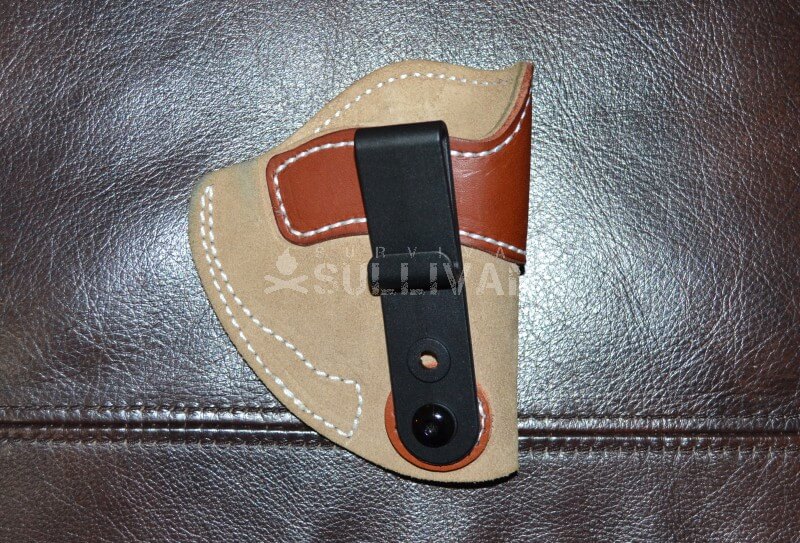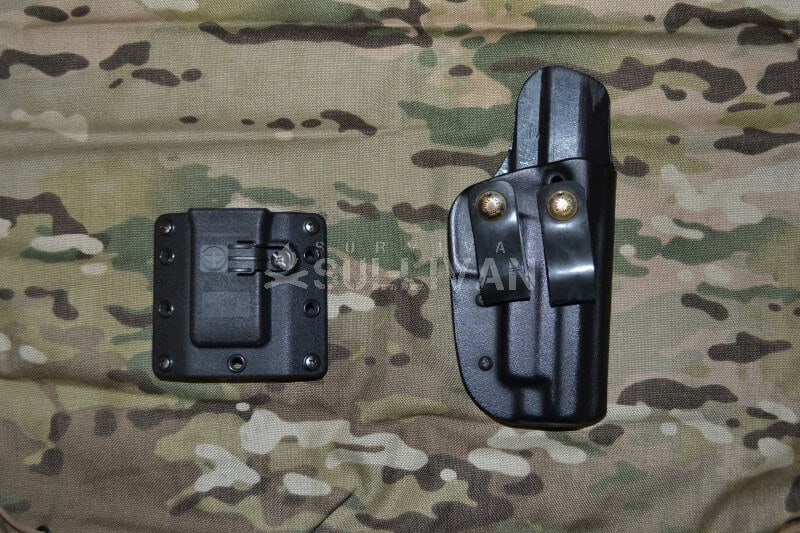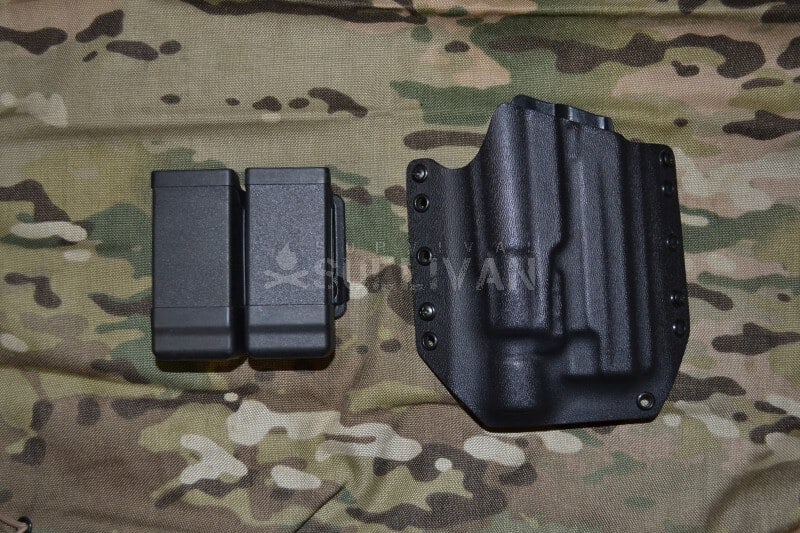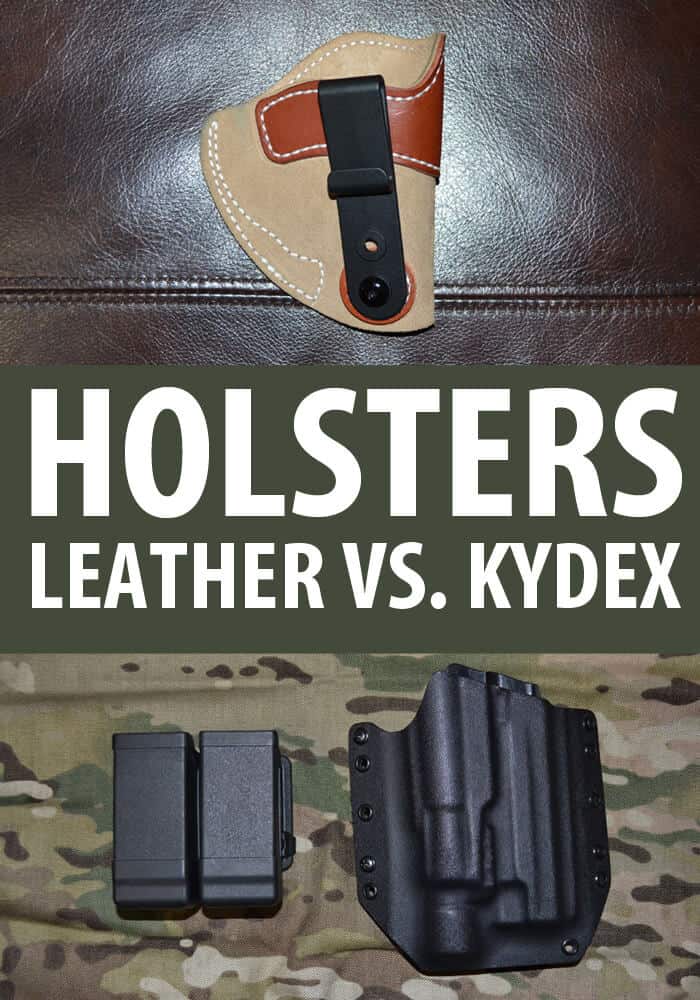A quality holster is critical piece of equipment for carrying and using a pistol safely and effectively. A good holster will securely hold the pistol and support it in such a way that its user can easily acquire their shooting grip for a fast, clean draw.
Moreover, the holster itself, at least one used for any serious purpose, must be rugged and durable, able to withstand rough treatment and harsh conditions without failing or compromising its retention.
There is a numberless amount of holsters on the market: a model for every handgun, carried in any conceivable way, in all kinds of colors and made from one of several kinds of material.
It is the last factor, material, that will greatly determine the performance and wear characteristics of a given holster. With few exceptions, those materials are almost always leather or kydex.
Leather is the timeless and time-honored traditional material of holsters. “Gunleather” is a term that both describes belts, pouches and holsters as a category and also describes leather suitable for making such equipment.
Kydex is a modern, light and tough thermoplastic, moldable to any shape imaginable. Once molded, kydex retains its shape and retentive properties forever, impervious to moisture and wear, only vulnerable to extreme heat or breakage.
Both of these materials are synonymous with holsters, and both have advantages and die-hard, dedicated advocates. But is one really better than the other? Can there be room for both in a shooter’s drawer? In today’s article we will take a long look at both of these great holster-making materials and leave that decision up to you.
Characteristics of a Good Holster
Before you can compare leather and kydex against one another for holster-crafting suitability, you must first understand what makes a good holster, well, good.
A quality holster, no matter what type or how it is made, will hold a pistol securely upright in the course of being carried. The holster will accomplish this by being rigidly molded to the shape of the gun as precisely as possible.
Friction is the name of the game, but this is where the art of holster-making comes in. The fit of the holster to the gun cannot be too tight, lest is furnish a too slow draw, one where the shooter must snatch at the pistol to free it. A too loose fit is sloppy, allowing the gun to move around and inevitably letting it fall disastrously out of the holster.
The ideal is one of balance: a fit neither too tight nor too loose, so the holster will retain the gun securely during normal movement like walking, running, crouching and crawling but will release it with a tug, other retention mechanisms notwithstanding.
Furthermore a holster must also be itself rigid, and its mounts for the gun belt designed and made in such a way that it will stand upright without sagging or slumping to either side, provided that of course the belt it is hanging from is also rigid and quality.
This characteristic is essential for a good draw, as the shooting hand should not need to yaw inward or outward to acquire the master grip on the pistol.
When the time comes to reholster the pistol, the holster should be upright and proud, and the mouth, or opening, of the holster should never collapse when the gun is in hand; either occurrence is a serious flaw, as having to use one hand to reposition the holster to accept the pistol or, worse, hold it open is a safety hazard and certainly inefficient.
Lastly the holster and its attachment method must be physically rugged and tough to withstand the travails of use sure to accompany any working pistol.
Beyond use, abuse and wear, a holster may need to prove resistant to direct attack, as a fight over the gun itself may see a weak or flimsy holster ripped clean off the carrier’s body with the pistol inside it.
Beyond these essential characteristics for use, there are many variants of holster, each with its share of options and perks.
I have talked of many of them at length before in other writing, but broadly speaking from here on the benefits of leather or kydex respectively will apply to any of them and the good news is that both leather and kydex are completely suitable for nearly any kind of holster.
The only trick, then, is deciding which one is right for you, or right for your task.

Leather
Making a holster from leather is a true art, one that requires considerable experience and extended apprenticeship to ever truly master. Long before a stitch ever touches animal hide, there is much to consider for the holster maker to produce a quality, effective holster.
The type of animal, be it cow, horse or some other more exotic species, will furnish leather with differing qualities each better suited to particular projects. Beyond that the cut of hide, shoulder, belly, back and so on, similarly determines the final properties of the nascent pistol rig.
Once a hide is harvested it must be tanned to produce the leather, the raw stuff of holster making. The leather will ideally be vegetable tanned, so that the tanning salts will not leach out and rust the firearm it carries.
The leather will then be sorted by thickness, which is an essential characteristic for a pistol holster: thicker leather, worked properly, will often be stiffer and more durable than thinner, softer leather.
Once suitable leather is readied, it will be molded to a gun, formed, shaped, dyed and stitched to produce a holster. Handcrafted leather holsters made by a master are some of the most treasured pieces of gear in any shooter’s collection, and a joy to wear. For a very long time, leather was the holster making material. There was no other that offered its combination of strength and fitment.
Advantages of Leather
A leather holster is soft to the touch, and has some flex. They do a great job of covering up the often brutally hard and cold steel edges of pistols.
This can make them very comfortable to wear as the gun is said to move with the carrier more than hard and unyielding kydex, and is definitely more forgiving when pressing against your body.
Leather is “quieter” than kydex, producing nothing more than a characteristic, soft, sussuring shhrik when the pistol is drawn or holstered. This is not a huge deal, unless it is: sometimes a discreet draw is required and the loud clacking produced by a kydex holster is far from subtle.
Good leather holsters are rightly admired for their “just right” level of retention: the gun carries and rides like it was born there, and is neither too tight nor too loose, affording great security and a clean, fast draw.
Lastly leather is largely invulnerable to all but the most extreme heat or cold, though those extremes can dry it out and make it brittle if it is without care long enough.
Disadvantages of Leather
Leather is skin, and like all biological material, it is vulnerable to breaking down unless it is maintained scrupulously. While the top-quality working leather holsters from good manufacturers will shrug off bad weather and mistreatment at first, such will eventually catch up to it.
Leather will over time lose its retentive qualities as it ages and incurs use, and mistreatment in the form of copious sweat baths, water, mold, mildew and other hazards will greatly accelerate its decay. All of the preceding will need to be attentively dealt with.
Leather’s greatest disadvantage is that once it weakens, it can flop, collapse and generally lose its shape. A collapsed mouth is a safety hazard, one that may result in an unintended discharge and is especially prevalent on IWB leather holsters. Lost shape will equal less retention.
Leather is largely non-configurable once made. There is no changing of snaps, loops, straps or anything else on a leather holster once it is made. The attachment system it comes with is the attachment system it will wear until decommissioned. Leather holsters may feature a bossed screw or two to adjust tension on the gun, but these are comparatively rare and do not work as well as kydex holster equivalents.
Leather is also ounce for ounce far more expensive than synthetic kydex when made at an equivalent quality level.
You can have a world-class kydex holster for $75 or so, while an equivalent leather holster will start around $135 and go up fast from there. Combined with its greater overall vulnerability, leather holsters cost more to maintain and replace than kydex.
Lastly, leather absorbs moisture, particularly sweat. While the holster itself will bear this more or less gracefully depending on type of leather and maker, it can be highly damaging to the finish of a gun left inside it while so inundated. Kydex is moisture impermeable, completely waterproof and will stop all save condensation from reaching the pistol through it.

Kydex
Kydex is a thermoplastic material first used for forming lightweight aircraft interior parts. It is available in a wide range of weights and types, each with their own properties, not too dissimilar to leather.
The differences after this are drastic: kydex, once formed, is essentially maintenance free. It is impervious to and absorbs no water, cannot be attacked by mold, salt or germs, needs no break-in period, and is utterly resistant to abrasion and warping from all but intense direct heat.
Contrary to popular belief, kydex is not injection molded, as kydex sheets are not rendered into a molten state as with plastic. Kydex, like leather, is also formed and pressed around the gun to form a holster, only kydex must first be heated to make it pliable.
Once this is done, typically using two sheets, front and rear, they will be drilled and riveted together, permanently bonding the two halves. Then the excess material is trimmed away, the edges burnished and polished, and attachment points, often belt loops will be attached to the rivet holes using Chicago screws.
The resulting holster is one that will last basically forever unless destroyed. Its retention properties will never change, it will never loosen over time, and it will not break down from even the most grueling use schedule.

Advantages of Kydex
Kydex is a modern material that, on the surface, surpasses leather in almost every way as a holster material. As mentioned it is impervious to most environmental conditions, chemicals, moisture and all but extreme heat.
Those characteristics mean your holster will never wear out or get to sloppy to use. All that is required is occasional testing and thread-locking of adjustment screws for retention, if the holster uses them, and screws holding on belt loops.
Those screw-on attachment points allow a degree of flexibility, even modularity that is unattainable with leather. Loops can be exchanged for snap-loops, or clips. An IWB holster can be configured for OWB.
A drop-and-offset rig can be added, or a holster configured for MOLLE attachment on a warbelt. Kydex construction methods provide great flexibility with many models.
Kydex is also far more rigid than leather, and can be thinner while maintaining great strength and rigidity. This means the overall profile of a pistol in a kydex holster can be leaner than the same gun in a leather holster, but more importantly means that a kydex holster will always stand open ready to receive the gun when reholstering, no need to use another hand to hold or prop it open.
The intricate flexibility and molding properties of kydex means it can be precisely fitted to any imaginable object to produce a “second-skin” fit with a robust level of retention, no snaps or straps needed. No object it too small or too oddly shaped to fit kydex to.
Kydex, as befitting a modern high-tech polymer, are more affordable than leather in most instances, and you can get a very good kydex holster for well under $100. High quality leather holsters in that price bracket are few and far between, and quality construction is crucial for a leather holster to give good performance.
Disadvantages of Kydex
Kydex is a hard material with very little flex or give. While it will keep the sharp and steely edges of your pistol off of your tender, tender flesh, the kydex itself is nowhere near as pleasant as leather is against your skin. For this reason, kydex readily creates hotspots when tightly pressed against you.
Kydex is also noisy. On the draw or when reholstering kydex will often produce loud clacking sounds on contact with the gun. Even drawing slowly will usually produce a distinct click as the built-in, fitted retention of the holster is overcome. This is, once more, not an issue unless it is…
Lastly, kydex holsters are a little more fragile with the gun out of them. If crushed, stressed or twisted beyond structural limits, a popped rivet or even cracked material may result, often ruining the holsters retention. A small thing, but the flexible nature of leather makes it resistant to the same forces, and only monumental tearing force or cutting will otherwise ruin it.
Verdict
Both materials, executed properly, still produce excellent holsters. Bottom line, though, you can get a far more effective, long lasting holster, and get it cheaper, with kydex than with leather.
Leather is great, bit is largely obsolete for hard-use holsters for all the reason listed above. Leather remains the classic and classy choice, and is utterly beloved, but for practical purposes kydex is the new and future king.
If you absolutely have to have leather, warts be damned, you can still have a holster you can bet your life on so long as you are willing to pay, and wait, for quality.
The common gunshop-variety $20 and $30 leather holsters that are so common all over these days are literally not worth $5. They wear out in no time, and don’t have any good characteristics to begin with. Anyone who claims otherwise, that they are adequate in any essential way does not know holsters.
Conclusion
Ultimately you may find room in your heart (and safe) for both leather and kydex pistol holsters. Kydex for OWB use, and leather for IWB. Or perhaps you will choose as the great Ken Hackathorn does and go with leather for steel guns and kydex for plastic guns.
Whichever you choose, choose quality first and you can be sure you’ll have a rig that will last you for many years.


Charles Yor is an advocate of low-profile preparation, readiness as a virtue and avoiding trouble before it starts. He has enjoyed a long career in personal security implementation throughout the lower 48 of the United States.
